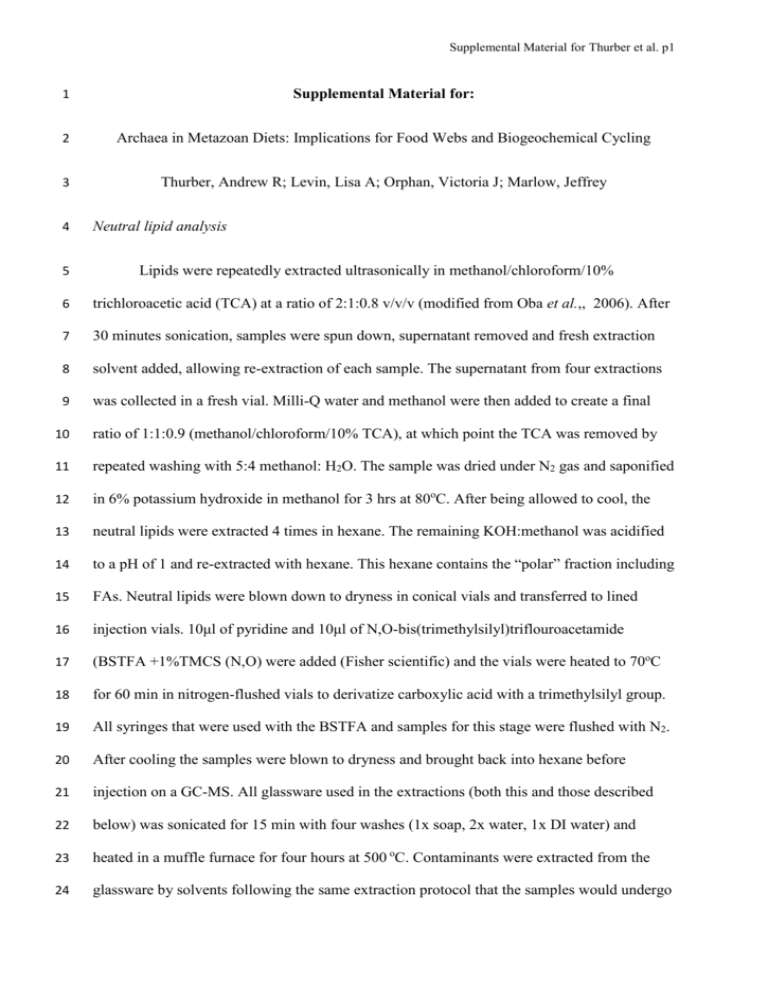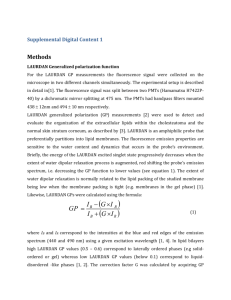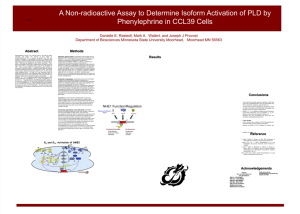Archaea in metazoan diets: implications for food webs and
advertisement

Supplemental Material for Thurber et al. p1 1 Supplemental Material for: 2 Archaea in Metazoan Diets: Implications for Food Webs and Biogeochemical Cycling 3 Thurber, Andrew R; Levin, Lisa A; Orphan, Victoria J; Marlow, Jeffrey 4 5 Neutral lipid analysis Lipids were repeatedly extracted ultrasonically in methanol/chloroform/10% 6 trichloroacetic acid (TCA) at a ratio of 2:1:0.8 v/v/v (modified from Oba et al.,, 2006). After 7 30 minutes sonication, samples were spun down, supernatant removed and fresh extraction 8 solvent added, allowing re-extraction of each sample. The supernatant from four extractions 9 was collected in a fresh vial. Milli-Q water and methanol were then added to create a final 10 ratio of 1:1:0.9 (methanol/chloroform/10% TCA), at which point the TCA was removed by 11 repeated washing with 5:4 methanol: H2O. The sample was dried under N2 gas and saponified 12 in 6% potassium hydroxide in methanol for 3 hrs at 80oC. After being allowed to cool, the 13 neutral lipids were extracted 4 times in hexane. The remaining KOH:methanol was acidified 14 to a pH of 1 and re-extracted with hexane. This hexane contains the “polar” fraction including 15 FAs. Neutral lipids were blown down to dryness in conical vials and transferred to lined 16 injection vials. 10μl of pyridine and 10μl of N,O-bis(trimethylsilyl)triflouroacetamide 17 (BSTFA +1%TMCS (N,O) were added (Fisher scientific) and the vials were heated to 70oC 18 for 60 min in nitrogen-flushed vials to derivatize carboxylic acid with a trimethylsilyl group. 19 All syringes that were used with the BSTFA and samples for this stage were flushed with N2. 20 After cooling the samples were blown to dryness and brought back into hexane before 21 injection on a GC-MS. All glassware used in the extractions (both this and those described 22 below) was sonicated for 15 min with four washes (1x soap, 2x water, 1x DI water) and 23 heated in a muffle furnace for four hours at 500 oC. Contaminants were extracted from the 24 glassware by solvents following the same extraction protocol that the samples would undergo Supplemental Material for Thurber et al. p2 25 to remove any remaining lipids within the vials. Blanks were run concurrently with all 26 sample sets. 27 Fatty Acid Analysis 28 This reaction used an extraction solvent of 3ml of 10:1:1 methanol: chloroform: 29 hydrochloric acid (v:v:v; Lewis et al., 2000), which was added to the previously freeze-dried 30 samples. Worms were ground within this solvent using a glass rod prior to being sonicated 31 for 10-15 minutes. After heating to 90OC for 1 hour in a dry block, samples were allowed to 32 cool, and one ml of Milli-Q water was added. The newly formed fatty acid methyl esters were 33 extracted in 3 aliquots of 2ml 4:1 chloroform: hexanes (v:v). Worms were blown to dryness 34 in N2, weighed, and brought up in an appropriate amount of the chloroform: hexanes mixture 35 for injection and analysis by GC-MS. The extraction-transesterification method was modified 36 to extract the E3 carbonate itself. Rock (1.3g) was pulverized in a methanol cleaned, dry-ice 37 chilled mortar and pestle and then added to a vial with methanol: chloroform: hydrochloric 38 acid (HCl) extraction solvent. 12N HCl was added until degassing stopped (from the 39 carbonates reaction with the extraction solvent) until a final pH of 1.5 was achieved (the 40 starting pH of the solvent). From that point forward the rock was extracted as above. 41 All lipid and FA samples were analyzed on a Thermo Finnigan Trace GC-MS with a 42 TR-5MS 60m x 0.32m i.d. column in positive-ion mode. Sample oven conditions for fatty 43 acid analysis were an initial hold at 60 oC for 1 minute, heating from 60oC to 180oC at 12oC 44 per minute, then an increase to 250 oC at 2.5 oC per minute where samples were held for 30 45 minutes. Neutral lipids were injected at 70 oC and raised to 160 oC at 20 oC per minute and 46 then at 4 oC per minute to 310 oC. Blanks were run with all batches and all solvents were ACS 47 grade or better. In the instance where blanks did indicate peaks, these were subtracted from 48 co-extracted and analyzed samples. Peak integration and identification were performed based Supplemental Material for Thurber et al. p3 49 on the full mass spectra using Xcaliber © software (Thermo Scientific), comparison to known 50 standards (Supelco 37 Component FAME mix and Supelco Bacterial Acid Methyl Ester mix, 51 Sigma-Aldrich), and dimethyl-disulfide derivatization (following Nichols et al., 1986) for 52 identification of mono-unsaturated bond location. Identification of neutral lipids was based 53 on comparison to published mass spectra. The FAs are named using the scheme (carbon 54 chain length):(number of double bonds) and the location of the first double bond from the 55 terminal methyl end is given as X in the (n-X) notation. Cyc17 indicates a ring structure and 56 a and i prefixes indicate a branch in the anteiso or iso position, respectively. 57 Carbon isotopic analysis 58 For “13C Bulk” analysis, individuals, or fractions thereof, were placed in tin-boats at sea 59 after gut evacuation, dried at 60oC overnight, and acidified with 1% platinum chloride to 60 remove any inorganic carbon. “13C Bulk-Lipid” involved taking both the neutral and polar 61 fractions from the neutral lipid extraction method, placing them in double tin boats and 62 evaporating the solvents under a stream of dried N2 gas. Solvent blanks were run 63 concurrently and the d13C results were corrected using a carbon mass-balance approach. 64 These “13C Bulk” and “13C Bulk-Lipid” samples were analyzed on a Eurovector elemental 65 analyzer interfaced with a continuous flow Micromass Isoprime isotope ratio mass 66 spectrometer at Washington State University, a Finnigan Conflow 2 continuous flow system 67 and a Fisons NA 1500 elemental analyzer coupled to a Finnegan Delta S isotope ratio mass 68 spectrometer at Boston University, or a continuous flow PDZ Europa 20/20 isotope ratio 69 mass spectrometer at UC Davis. 70 For “13C Compound Specific” analysis, FAs were extracted using the one-step extraction- 71 transesterification technique; the FA composition was identified, percent FA calculated and 72 then the individual FAs were analyzed for 13C at the University of California, Davis Stable Supplemental Material for Thurber et al. p4 73 Isotope Facility on a Thermo GC/C-IRMS system composed of a Trace GC Ultra gas 74 chromatograph (Thermo Electron Corp., Milan, Italy) coupled to a Delta V Advantage 75 isotope ratio mass spectrometer. Analytical error was less than 1‰ for compounds specific 76 13C analysis (mean error = 0.5‰ ). Double-bond position was determined using retention 77 time in comparison to standards and comparison to GC-MS spectra analyzed. This method 78 also extracted the hydrocarbon crocetane allowing its isotopic composition to be analyzed. 79 The isotopic composition of the methanol used for methylation was measured at the 80 University of California, Davis and the isotopic composition of each FA was corrected for the 81 13C of this methanol. Blanks were run concurrently to determine the impact of contaminants 82 on the 13C of individual FAs. 83 84 Literature Cited 85 86 Lewis T, Nichols PD, McMeekin TA. (2000). Evaluation of extraction methods for recovery 87 of fatty acids from lipid-producing microheterotrophs. J Microbiol Methods 43: 107- 88 116. 89 Nichols PD, Guckert JB, White DC. (1986). Determination of monounsaturated fatty acid 90 double-bond position and geometry for microbial monocultures and complex 91 consortia by capillary GC-MS of their dimethyl disulphide adducts. J Microbiol Meth 92 5:49–55. 93 Oba M, Sakata S, Tsunogai U. (2006). Polar and neutral isopranyl glycerol ether lipids as 94 biomarkers of Archaea in near-surface sediments from the Nankai trough. Org 95 Geochem 37:1643-1654.







